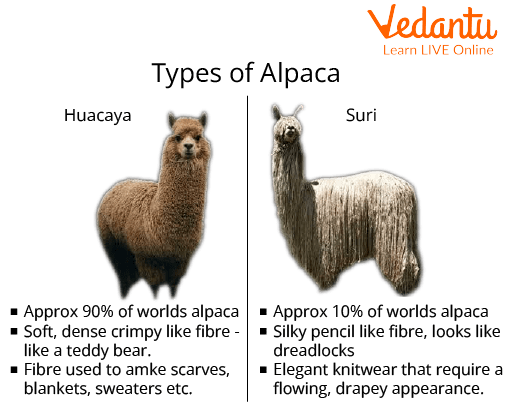What Is the Scientific Name of the Alpaca and Why Does It Matter?
Alpaca is the normal name for a trained, gregarious, high-height South American ungulate, Vicugna pacos (syn. Lama pacos), of the camel family (Camelidae), portrayed by an extremely lengthy neck, long and slim legs (yet short compared with the comparably seeming llama), little and prolonged head, short ears with slight places, short tail, and a split upper lip. While its local reach is in the high Andes mountains, this huge herbivorous vertebrate is not generally seen as in the wild, yet is kept up with broadly in homegrown crowds, to a great extent brushing in high rises of the Andes of Peru, Bolivia, Ecuador, and Chile.
Scientific Name of Alpaca
Vicugna pacos

Alpaca
Huacaya Alpaca
Huacaya is one of the two varieties that make up the species Lama pacos, ordinarily known as the alpaca (the other variety is the Suri). It lives on the Altiplano in the Andes, up to 4,000 metres (13,000 ft) above ocean level. Its normal reach includes four South American nations.
Alpaca Breeds
The alpaca comes in two varieties, Suri and Huacaya, in light of their filaments as opposed to logical or European characterizations.
Huacaya alpacas are the most ordinarily found, comprising around 90% of the population. The Huacaya alpaca is remembered to have begun in post-pilgrim Peru. This is because of their thicker wool which makes them more fit to get by in the higher heights of the Andes in the wake of being driven into the good countries of Peru with the appearance of the Spanish.
Suri alpacas address a more modest piece of the all-out alpaca populace, around 10%. They are remembered to have been more pervasive in pre-Columbian Peru since they could be kept at a lower elevation where a thicker downy was not required for cruel climate conditions.

Types of Alpaca
Where do Alpacas Live?
Alpacas can be viewed all through the greater part of South America. They commonly live in mild circumstances in the mountains with high elevations.
They are not difficult to focus on since they are not restricted to a particular sort of climate. Creatures like flamingos, condors, spectacled bears, mountain lions, coyotes, llamas, and sheep live close to alpacas when they are right at home.
The alpaca is economically raised too on different landmasses, outstandingly in North America and Australia. Alpacas are not utilised as pack animals, yet chiefly are esteemed for their fibre, and customarily have been esteemed additionally for meat, hair, stows away, and their fertiliser, utilised as fuel. They have been trained for millennia, even before the Incas, who raised and reproduced alpacas for materials held for sovereignty.
Interesting Facts
The birth weight of an alpaca is for the most part between 8-23 pounds. A female alpaca is thought of as experienced a year and a half and a male alpaca is developed at 2-3 yearsAlpacas normally live 15-20 years. The most seasoned alpaca is 27 years of age.
The antiquated Incas initially trained the alpaca quite a while back. They made robes of alpaca fur for the aristocrats and eminence.
Alpacas' stomachs have three chambers.
The single alpaca species has two varieties: the dreadlocked Suri and the cushy huacaya.
The greater part of the commotion alpacas make is murmuring. Contingent upon the circumstance, this communicates happiness, interest, weariness, mindfulness or trouble.
Alpacas are regularly sheared like clockwork, the suris yielding fine wools of around 3 kg (6.5 pounds) per creature and the huacayas giving coarser wools weighing around 2.5 kg (5.5 pounds). Hair development in two years is around 30 cm (12 inches) in the huacaya and 60 cm (23.6 inches) in the Suri. Individual filaments inside the wool range from around 20 to 40 cm (around 7.9 to 15.7 inches) long at the hour of shearing. Alpacas have a characteristic life expectancy of 15-20 years.
At the point when llamas cross with alpacas, the child is known as a huarizo.
Important Questions
1. What is the Population of Alpacas?
Ans: Alpacas are native to Peru, but can be found throughout the globe in captivity. It currently has the largest population, with over half the world's animals. The population declined drastically after the Spanish Conquistadors invaded the Andes mountains in 1532, after which 98% of the animals were destroyed. The Spanish also brought with them diseases that were fatal to alpacas.
European conquest forced the animals to move higher into the mountains, which remained there permanently. Although alpacas had almost been wiped out completely, they were rediscovered sometime during the 19th century by Europeans. After finding uses for them, the animals became important to societies during the industrial revolution.
2. What is the Lifespan of an Alpaca?
Ans: Alpacas are normally sheared every two years, the suris yielding fine fleeces of about 3 kg (6.5 pounds) per animal and the huacayas giving coarser fleeces weighing about 2.5 kg (5.5 pounds). Hair growth in two years is about 30 cm (12 inches) in the huacaya and 60 cm (23.6 inches) in the suri. Individual fibres within the fleece range from about 20 to 40 cm (about 7.9 to 15.7 inches) in length at the time of shearing. Alpacas have a natural life span of 15–20 years.
Conclusion
Alpaca is a flexible, warm, solid, water-safe crossbreeds delivered on a delicate, strong creature. Alpacas are 'green' creatures, simple guardians that are light on the land, having delicate cushioned feet with toes as opposed to hooves.


FAQs on Scientific Name of Alpaca: Definition, Facts & Importance
1. What is the difference between llamas and alpacas?
No, alpacas are not llamas. Alpacas and llamas are in the camelid family, however, each fills an alternate need.
Alpacas are a South American relative of the Camel. Closer family members incorporate the trained llama, the wild guanaco, and vicunas. This group of creatures began on the fields of North America around quite a while back. A typical predecessor of the South American camelids relocated to South America around 2.5 a long time back. Llamas and alpacas can in any case interbreed which is known as a huarizo. Alpacas are crossbreeds of the vicuna.
2. Why is alpaca so expensive?
There are many reasons that alpaca fibre is so costly. First of all, fewer are alpacas than the modern foundation is an absent foundation. There are something like 350,000 alpacas in the U.S., of which are not all great. The alpaca business gauges there should be somewhere around 1 million alpacas in the U.S. full-time plant and make it nable. From a point of view, there are 6 million sheep in the U.S. with plants ready to handle sheep's fleece into yarn at around $18 per pound though handling alpaca's fleece costs around $38 per pound.
3. Do alpaca fibre wick dampness as well as fleece?
Fleece has air which gives it a warm limit that can ingest up to half of its weight. It can sit on the skin without making any aggravations, and rankles fibre empty fibre, so it doesn't retain dampness but instead drives water away from itself and toward the fibre, and that implies there isn't an immersion point. For instance, James can wear his alpaca socks in rain boots (no ventilation) and sweat in the socks and beyond the socks will be soggy, however, his feet will be dry.










